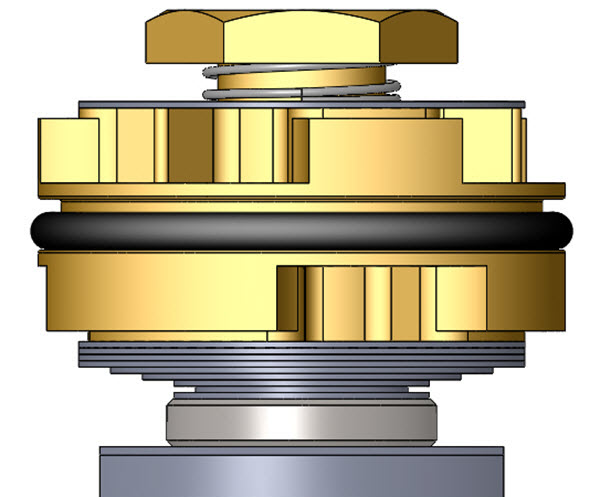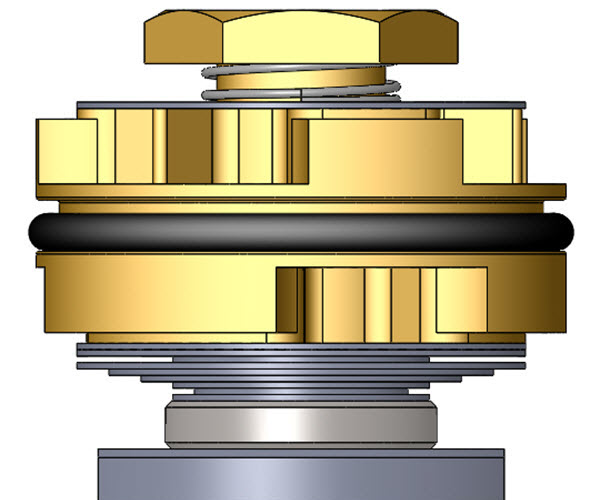FORK COMPRESSION | |||||||
Tools Required - In-lb torque wrench that accurately measures 0 to 50 in-lbs (0.58 kgf-m) (SnapOn Digital Torque Wrench shown) - Hi-Strength Loctite (included) - Metric calipers and micrometer | |||||||
VP1- You will be converting this from 8mm ID shims to 6mm ID. You will use the FAT o-ring supplied in the kit. Re-use the stock Nut and Sleeve Washer. Disassemble and clean the stock compression valve. | |||||||
VP2- Install the Base Plate on the Shaft.
The Base Plate will now rest on the step. We are converting this to 6mm ID shims instead of 8mm.
| |||||||
VALVING STACK TYPES - SINGLE OR TWO STAGE VP3- You will either be building a Single Stage or a Two Stage Stack. The difference is the Crossover. The Crossover is a smaller diameter shim between the Lo-Speed and the Hi-Speed Stacks. Note: The DVS Custom Setup Sheet displays individual shims and does not label Hi-Speed, Crossover, and Lo-Speed. This is for your information only. Also you will not use all the shims provided in the Gold Valve Kit.
| |||||||
VP4- Two Stage Example (Single Stage is exactly the same except there is no Crossover) Put the valving on the shaft in the reverse of the order listed, starting with the last (smallest) shim of the Hi-Speed Stack. For Two Stage the total valving stack is made up of a: Lo-Speed Stack Crossover and a Hi-Speed Stack | |||||||
VP5- COMPRESSION BLEED HOLE If your DVS Setup Sheet calls for a Compression Bleed Hole check to see if it is already pre-drilled in the piston. If it is not you will need to drill one. Notice that the bleed hole is on the side of the piston with the recess and is drilled sideways. It connects the two sides of the piston and bypasses the valving stack. The exact location is not critical. | |||||||
VP7- Install the Check Plate, Check Spring, and Sleeve Washer. | |||||||
VP8- Make sure the Total Valving Stack Height is correct. This step is here to insure you don't "run out of thread" when tightening the Nut and the Nut gets full engagement. The Sleeve Washer should cover the end thread so the Nut cannot run out of thread as it is tightened. If the Stack Height needs to be increased it is done with Spacing Shims. If needed, they should be added just above the Base Plate. Spacing Shims must be larger in diameter than the smallest shim in the stack. | |||||||
VP9- Apply a small drop of Loctite to the valving shaft nut. | |||||||
VP10- Check to make sure the check valve is free before the nut is tightened. | |||||||
VP11- tighten it to spec with a torque wrench. CAUTION! The threads can be damaged without extreme care. You must use Loctite. Torque the Nut to the spec on your DVS Setup Sheet. NO MORE! Do not take this step lightly.This is critical! | |||||||
| VP12- Single Stage | |||||||
VP13- Make sure the Check Plate is free and can move up and down against the Spring. | |||||||
VP14- Visually check your work. Hold the Valving Stack up to the light and look for proper assembly. If there are any problems, disassemble the stack and look for burrs to surface and/or dirt in the valving. Reassemble and check again. On two-stage stacks make sure the Crossover Gap is clearly visible. Make sure the o-ring is on the Gold Valve. Some kits contain more than one o-ring. See your DVS Setup Sheet Valving Cmments for the correct o-ring. | |||||||
VP15- Make sure the shims that go next to the Gold Valve completely cover the ports on both sides of the piston! If the ports are not covered there will not be enough damping. This could be caused by a number of reasons. Please call Tech Support if this occurs and you can't figure it out. | |||||||
VP16- Return to the main instructions and continue with Rebound Valving and Assembly. | |||||||
| • Single Stage - made of: Lo-Speed Stack Hi-Speed StackThere is NO Crossover (it becomes one stack.) |  |  |
| • Two Stage - made of: Lo-Speed Stack Crossover Hi-Speed StackThe Crossover Gap is visible |  |  |
















